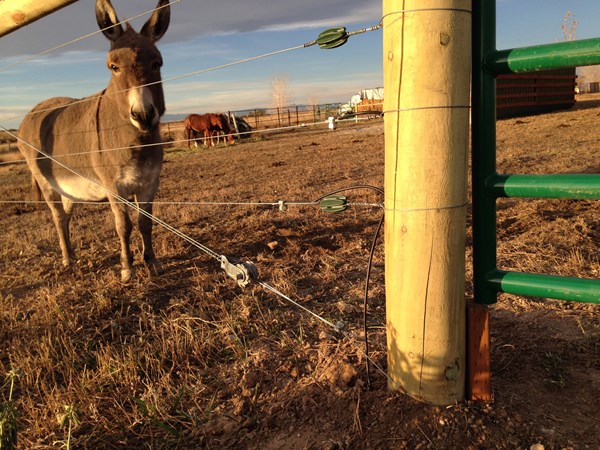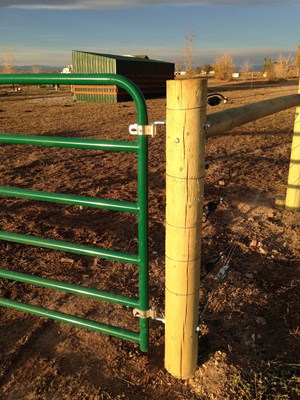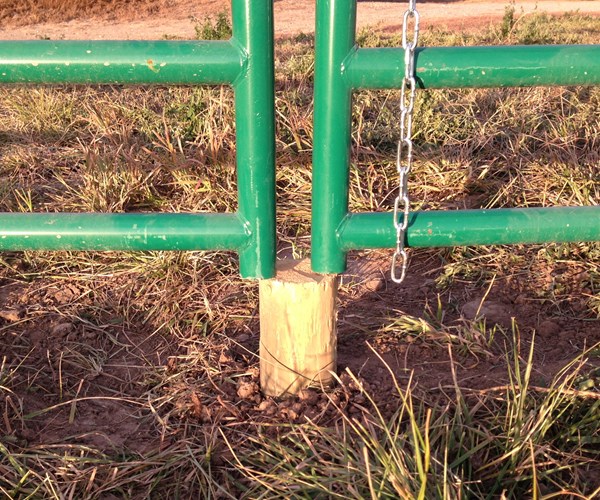 Credit: Kimberly S. Brown Sometimes something as simple as placing a block of wood on the latching end of the gate can prevent further sagging until you can adjust the post on which the gate hangs and swings.
Credit: Kimberly S. Brown Sometimes something as simple as placing a block of wood on the latching end of the gate can prevent further sagging until you can adjust the post on which the gate hangs and swings.Gates can become a heavy burden to open and close if they sag and drag, no longer swinging freely. Gate posts should be sturdy and set deep in the ground, preferably with a good brace in addition to the gate post.
But sometimes even well-set posts “give” a bit over time unless set in concrete. Ground that is wet or unstable won’t hold a post very well, especially for a heavy gate.Sometimes frost “heaves” push posts upward, then the gate won’t open or close properly. Posts may “give” during spring thaw, and over time a heavy gate can droop lower on the far end and start to drag on the ground.
Unfortunately the fix for these sags is to repair or replace the post and/or reset it in concrete. This, however, might have to wait until spring in some parts of the country so the concrete will set properly.
Some gates can be adjusted by tightening the bolts to the post; or you might have to re-drill the post to place the gate bolts in a different location.
 Credit: Kimberly S. Brown Some gates can be adjusted by tightening the bolts to the post; or you might have to re-drill the post to place the gate bolts in a different location.
Credit: Kimberly S. Brown Some gates can be adjusted by tightening the bolts to the post; or you might have to re-drill the post to place the gate bolts in a different location.Sometimes something as simple as placing a block of wood on the latching end of the gate can prevent further sagging until you can adjust the post on which the gate hangs and swings.
Occasionally a pole panel is used as a gate.Having to lift or drag the panel to open or shut it can be a back-breaking chore.This problem can be solved by attaching a small wheel to the end of the panel or sagging gate.The wheel takes all the weight and supports the gate–it cannot sag any farther–and enables it to move easily when you open or close it.You no longer have to pick it up and carry it to keep it from dragging.
Nearly any small wheel will work for this purpose, including old wheelbarrow tires, small discarded machinery tires, or metal wheels–the kind you find in junk piles or might salvage from a piece of ancient farm equipment.A wheelbarrow tire can be easily adapted so you can bolt one or both uprights–the pieces of metal that come down either side of the tire to hold its small axle–to a wooden gate or pole gate.
An old wheel or tire with any type of axle attached to it can be securely wired to a metal gate.The horizontal piece of axle can be fastened to the bottom rail or pipe.If you use stiff, strong wire and securely wire it at each end of the axle (close to the wheel, and at the opposite end) the weight of the gate will not alter the angle of the wheel very much.You want the axle securely attached to the gate so the wheel or tire will stay upright, with no wobble.Then it will roll freely, taking the weight without binding or catching.
If you have a double gate where machinery goes into a field you can help prevent sagging by properly installing the gate posts and by placing a “prop” under the center where the gates meet. Of course this prop needs to be temporary so it can be removed when machinery has to be driven into the field.
Of course, a major cause of gate sagging is people climbing over the gate instead of unlatching it. Make sure at your farm or stable that your staff and clients understand that climbing over gates (or fences) can cause them to sag and need repair.
Editor’s note: If you have other ideas on how to fix sagging gates, please share them in the comment section below.
 Credit: Kimberly S. Brown If you have a double gate where machinery goes into a field you can help prevent sagging by properly installing the gate posts and by placing a “prop” under the center where the gates meet.
Credit: Kimberly S. Brown If you have a double gate where machinery goes into a field you can help prevent sagging by properly installing the gate posts and by placing a “prop” under the center where the gates meet.


